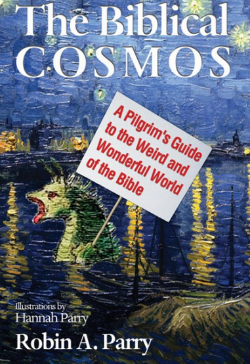The Biblical Cosmos By Robin Parry
A pilgrim's guide to the weird and wonderful world of the Bible - how the authors of the Bible saw the world
 The Biblical Cosmos. A pilgrim's guide to the weird and wonderful world of the Bible
The Biblical Cosmos. A pilgrim's guide to the weird and wonderful world of the Bible
by Robin A. Parry; illustrations by Hannah Parry
Cascade Books
ISBN 978-1-62564-810-5
Reviewed by Pieter J. Lalleman
Most of this book is dedicated to explaining how the authors of the Bible saw the world: radically different from how we see it.
Parry makes it clear that they did not differ much from their contemporaries in seeing the earth as flat, the sky as a dome over it, etc. He deals with the sea, hades, deserts and mountains; see page 43 for why we should say that Jesus walked on the sea, not on the water!
A separate part of the book discusses the temple which was an image of the cosmos. All this is not exactly new to theologians but Parry presents it in an easy-to-read style accessible for many.
At the end he raises the question of what these insights mean for modern believers, for example how we should think about the ascension of the Lord Jesus. In this way he offers not merely facts but also their meaning.
He defends a Christian Platonism which respects God as the essence of the universe and he presents the unique position of Jesus within it. Some of what he says in this last part of the book is a bit more speculative and in places readers may come to different conclusions. I for one would keep Creator and creation a bit further apart.
On the other hand it would have been helpful to get Parry’s insights into the development of computers and robots which are becoming ever more ‘human’.
For believers the Bible is a unique book, but it turns out that its cosmology has much in common with that of the surrounding nations and this may come as a bit of a shock to readers. It requires a certain maturity of faith to handle the information contained in this book but Parry is very aware of this, so he presents it gently.
The final part of the book is hard in a different way, in that it is more technical and thus harder to follow than the earlier parts. Parry throws in more theology and philosophy here, and I think it requires theological training to appreciate it. This is a shame because the subject is relevant for all. That Parry here writes for educated readers is also evident in the way in which he refers to ancient sources by means of standard abbreviations.
Dr Pieter J. Lalleman teaches New Testament at Spurgeon’s College
Baptist Times, 23/07/2015